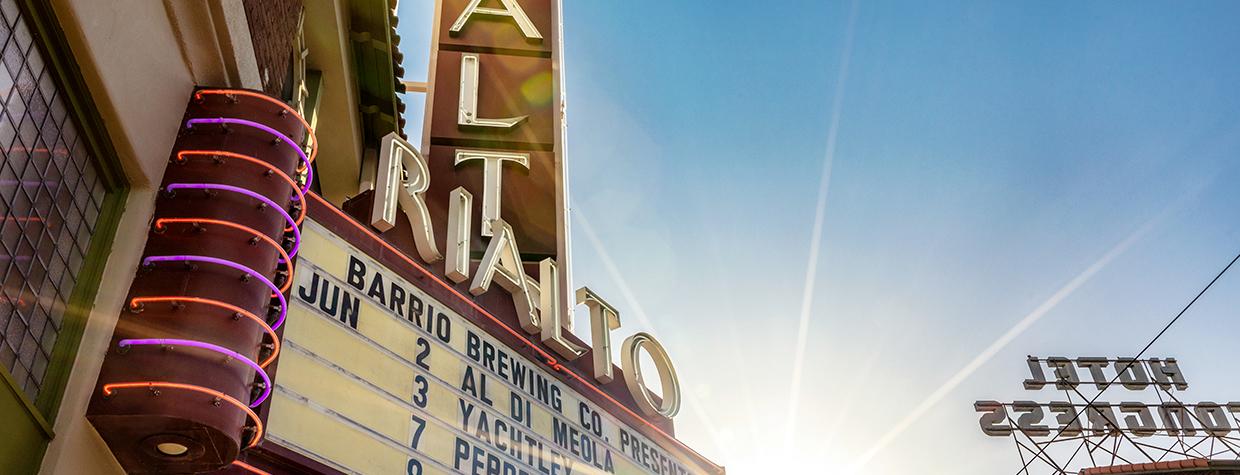The first time I visited Tucson, in 1973, I stayed in a comfortable downtown hotel, interviewed for a reporting job in a downtown newsroom and went for a downtown walk with the city editor. He showed me the new art museum and symphony hall, an ambitious new maze-like shopping and office complex, and a surrounding ring of historic neighborhoods that seemed primed for a preservation wave. Although there were few people outside on the sidewalks — briefly, I wondered why — it seemed as though the city had a beating heart with an auspicious future.
I took the job, moved to Tucson and went to work downtown. Within months, Steinfeld’s department store shuttered and Tucson’s two newspapers decamped for a remote outpost among the industrial warehouses and creosote bushes on the city’s southern fringe. The next year, the hotel where I’d stayed shut down, as did the Fox Theatre. The remaining clothing and department stores expired within the next six years. By 1980, downtown had slouched into irrelevance, and there it would languish for decades.
Did it matter? Tucson has never needed a bristling skyline to establish character; its natural setting in a cradle of four imposing mountain ranges does that more convincingly than architecture ever could. Connected by digital streams, modern business and commerce work fine without being physically clustered. But lacking a living downtown, Tucson somehow felt incoherent. It was a galaxy without gravity to give it form, a blob of civilization oozing pointlessly about the desert. In 1995, I wrote an Arizona Highways piece making the case for Speedway Boulevard, a 19-mile east-west artery, as Tucson’s de facto downtown: Everything you could want, from a stiff drink to fine art to a university education, was lined up along Speedway. But it didn’t truly work as a city center. Downtown is a place for people to gather and do things. Speedway was, and is, a gathering of cars.
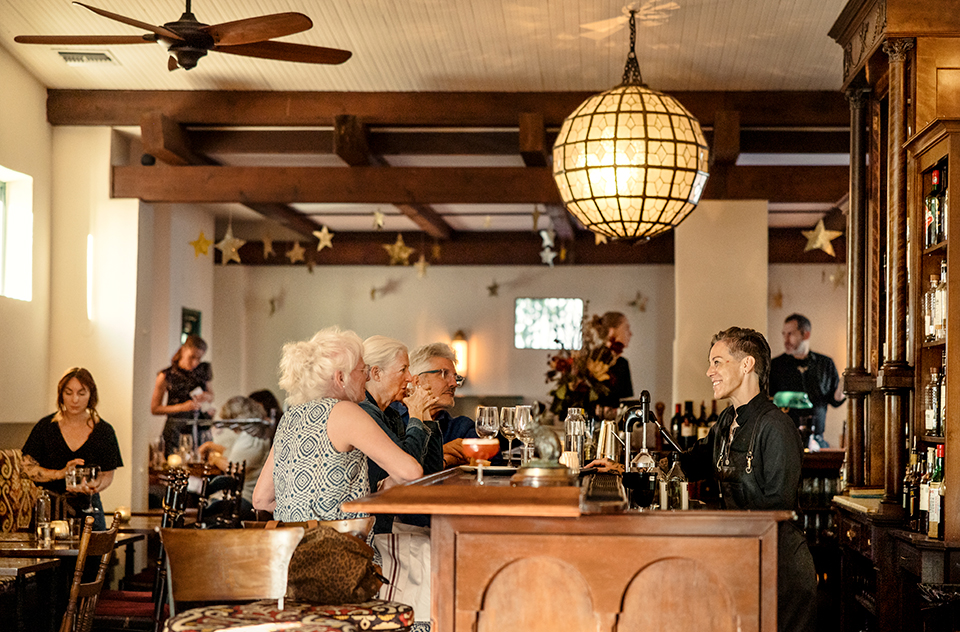
Innumerable plans were floated for reviving downtown: a throng of museums, including, bizarrely, an aquarium; a new arena inspired by desert tortoise shells; and a stunning $350 million suspension bridge, designed by star architect Rafael Viñoly, over Interstate 10. Committees burned millions of dollars hatching such ideas, and almost nothing came of them. The vapors of abandoned schemes became downtown’s tragicomic signature. In 2013, columnist Tim Steller of the Arizona Daily Star proposed an Urban Plan Museum to memorialize all the shelved projects. It was satire, but in the light of history, it didn’t even sound ridiculous.
But then, in 2020, on one of my annual visits back to Tucson, friends and I had a Friday night dinner reservation at a downtown restaurant. First surprise: It was hard to find a parking place. Second: The streets were alive and awake. Live music wafted polyphonically from several different clubs. There were people on the sidewalks, some even in flocks waiting outside restaurants.
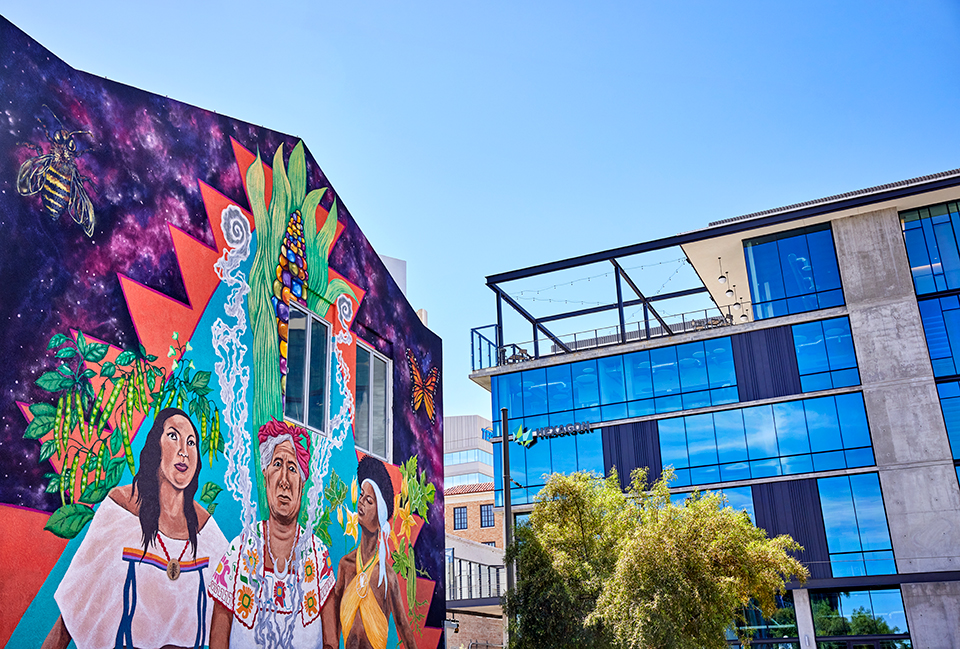
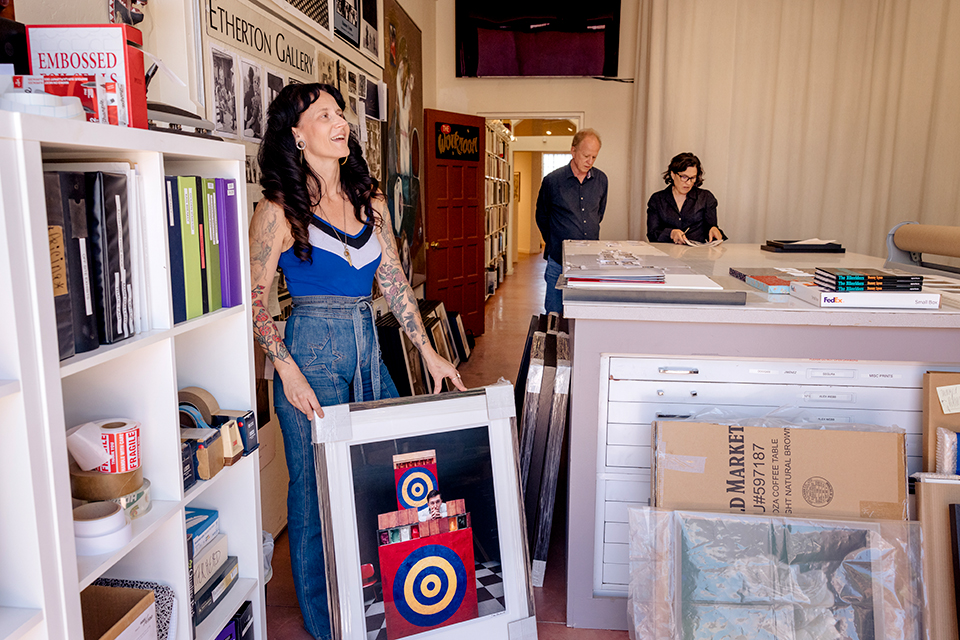
What was happening?
The key figure to explain it is Fletcher McCusker, a 73-year-old native Tucsonan. He has a history and emotional connection with downtown that stretches back to his childhood in the 1950s, when the arc of a week would curl naturally into a downtown weekend. “I was in the Mickey Mouse Club at the Fox Theatre,” he says. “There was a Saturday morning movie and cartoon for, I think, 50 cents. Every Sunday, my family would have lunch at the original El Charro.”
McCusker moved away after college but returned in 1996 to launch Providence Service Corp., a national social services provider. He set up Providence’s headquarters on the east side, and it grew rapidly to some 350 employees. In 2010, he called an all-staff meeting to brainstorm ways the company might give back to the community. “Someone in the back raised a hand,” he recalls, “and said, ‘We should move downtown.’ The rest went, ‘Oh, no! It’s a ghost town.’ I said, ‘Let’s go look around.’ ”
Providence moved downtown, and McCusker became an enthusiast. Unpredictably, he figured out that the future of a vital city center wasn’t in attracting businesses like his, but in entertainment — food, drink and especially music. Tucson’s grand plans for downtown, McCusker believes, were all flaming out because they were essentially government projects, hatched in bureaucracies and infected by staid and conventional thinking.
The white-haired McCusker deploys the word “hip” a dozen times in an hourlong conversation about reviving downtown. Austin is hip. San Diego is hip. Their key, as it would be for Tucson, is food and entertainment — and these are not things government agencies are great at generating.
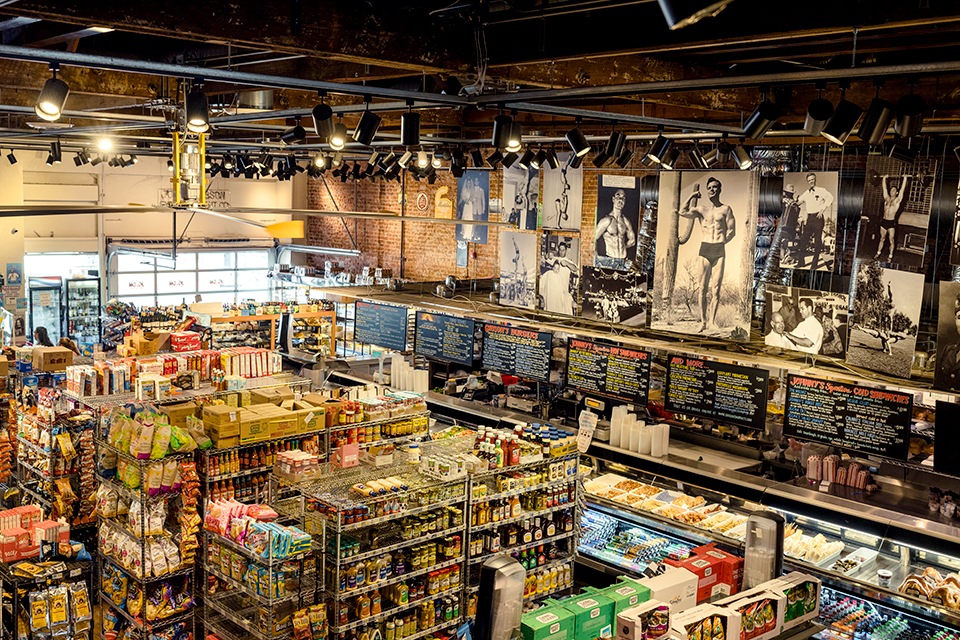
In 2012, the Arizona Legislature, which had been providing much of the funding for the stillborn revival, appointed McCusker chairman of the board of Rio Nuevo, the agency that had been hatching the revival plans. Rio Nuevo’s new approach, he decided, would be encouraging entrepreneurs with seed money. “We would loan them money; we would donate property,” he says. “We were determined to be very aggressive in stimulating downtown activity.”
McCusker might not put it this way, but he’d stumbled onto a key principle: The mistake city planners keep making is planning cities. While order is hardly a bad thing for civilization, when directed through official channels, it tends to reflect conventional thinking and shun controversy. Predictability trumps spontaneity. But what kind of city center bursts with life? The opposite: the fresh, the unpredictable, the unofficial.
A little-noticed, very unofficial event back in 1982 illustrates. The Chicago Symphony Orchestra, one of the world’s greatest orchestras, was scheduled to perform in Tucson at the downtown Music Hall. But a mountain blizzard delayed the truck carrying the musicians’ instruments from their previous engagement, and the concert was canceled at the last minute. The truck arrived later, however, and some of the musicians drifted over to the one upper-crust bar remaining downtown, formed an ad hoc jazz band and jammed deep into the night. A few lucky bar patrons were privy to an unforgettable experience.
Even through the dormant decades, Tucson’s downtown had a few things going for it. The established arts organizations thrived — the Tucson Symphony Orchestra, Arizona Opera, the Arizona Theatre Company, the Tucson Museum of Art. The latter sprawled outward from its Brutalist mother ship to incorporate five restored historic homes in the block around it, creating a fetchingly diverse and attractive campus. The historic downtown residential neighborhoods gradually spruced themselves up, block by block.
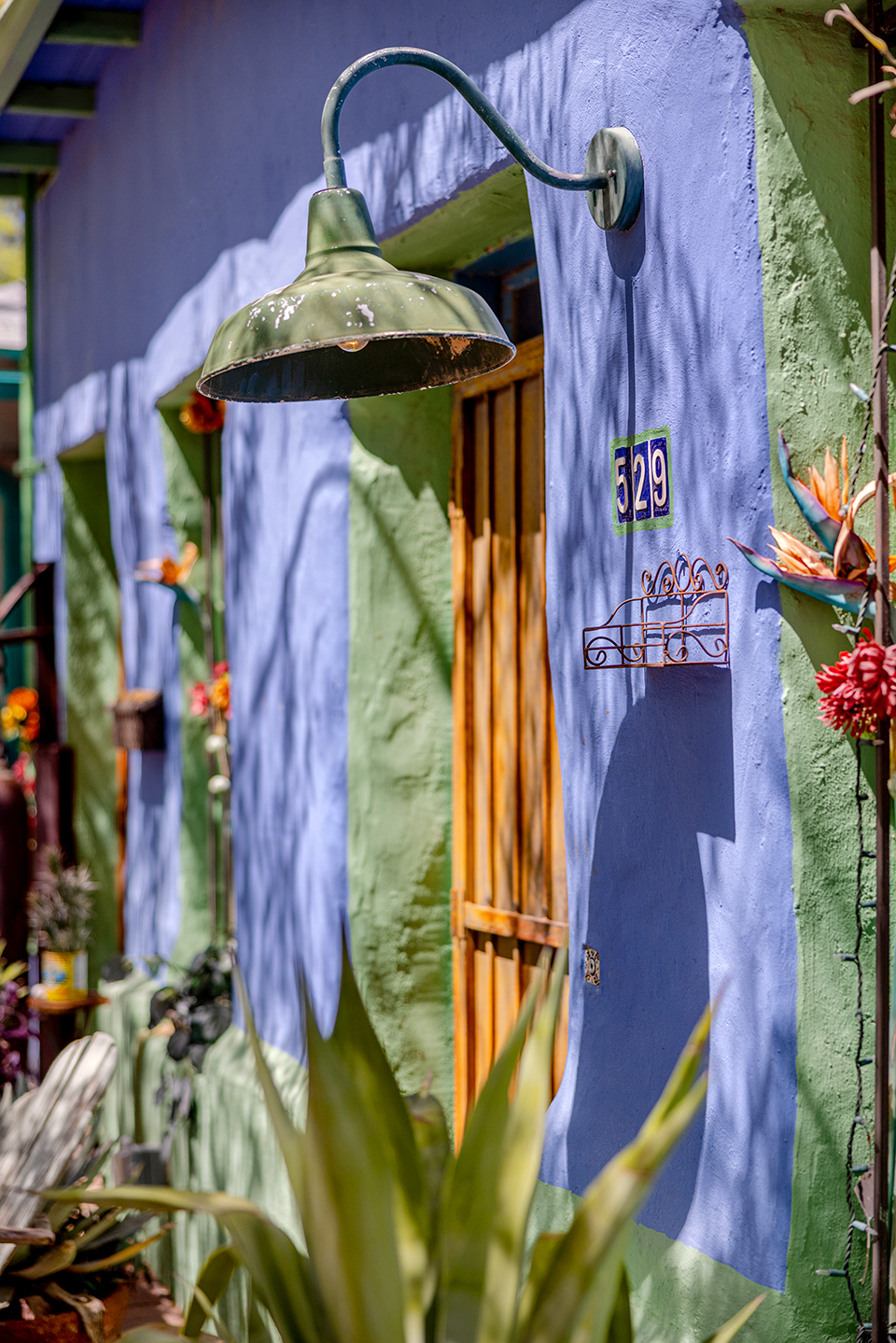
Barrio Viejo was, and is, especially significant. Walk a block south of the modern police station and convention center, and the streetscape could have been transplanted from northern Mexico circa 1870 — which, in effect, it was. The historic homes are mostly adobe row houses built right out to the sidewalk, with shared courtyards in back. In 1971, a Tucson native named Kelley Rollings began buying and renovating one or two at a time, stabilizing them and preserving their quirks where feasible. “If a back door was 5 feet high, he left it that way,” says Don Rollings, who has continued his father’s Barrio redevelopment. “It’s not modern; it’s not perfect. Tenants are here because they appreciate what it is.”
The Fox was another success, though fitful. The theater opened in 1930 as a vaudeville and movie house, closed in 1974 and by the 1990s was nearly beyond resuscitation from vandalism and water damage. But in 1999, a nonprofit foundation bought it for $250,000 and embarked on a six-year renovation that soared in cost to some $14 million, far more than the original estimate. It reopened on New Year’s Eve in 2005 as a venue for concerts, stage shows and classic movies, and while it bled money for years and needed infusions of subsidies and loans, there was a feeling around the city that the renovation had been done beautifully — and that maybe, just maybe, it was the embryo of downtown’s rebirth.
Fast-forward to the 2020s and an amble down Stone Avenue, downtown’s main drag, and its east-west tributaries. There are five new or renovated hotels open since 2017. There’s a hyper-trendy new restaurant I sampled just last night, and while it was excellent, I’m remembering the server who quietly warned me off a $7 appetizer: “It’s, like, one bite.” There’s a dramatic new apartment building at Stone and Broadway Boulevard, the RendezVous Urban Flats, a building with sizzling acute angles and an urban vibe that feels more like 21st century San Francisco than the sleepy Old Pueblo. Just when I’m wondering whether Tucson might have left its roots behind, there’s this poster at the Fox advertising an upcoming concert: “Six talented groups led by members of the Ronstadt family.”
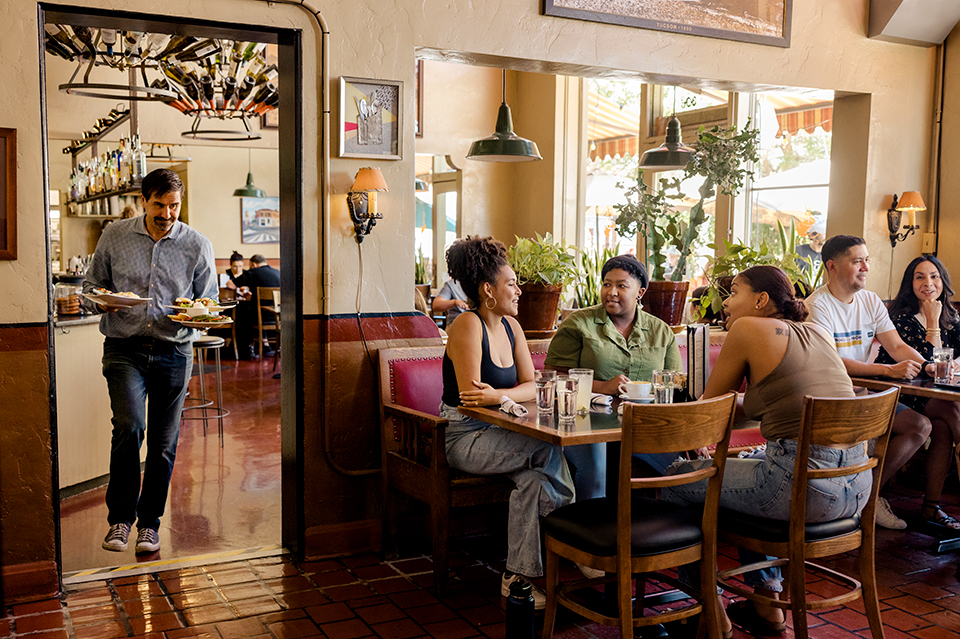
That’s the Ronstadt family, whose Tucson roots date to 1882, when Federico José María Ronstadt arrived from Mexico and became progenitor of a wide-branching tree of musicians including granddaughter Linda and a flock of her siblings, nieces and nephews. The Fox, now hosting some 150 events annually, seems safely grounded in the city’s culture.
More than anything else, music has been orchestrating the downtown turnaround. The Tucson Symphony Orchestra has played downtown since 1971, when the Tucson Music Hall (now renamed the Linda Ronstadt Music Hall) opened as part of the then-new Community Center complex. The historic Rialto Theatre, which opened in 1920, closed in 1963 and periodically resurfaced with Spanish-language and then pornographic films. But, like the Fox, it finally slipped under the protective wing of a nonprofit foundation, enjoyed a thorough makeover and became a major concert venue. Across Congress Street from the Rialto, the renovated, 104-year-old Hotel Congress now bills itself as “an urban, historic rock ’n’ roll hotel” and gives guests earplugs, but not refunds, in case they’re annoyed by the loud music. Bands play nightly on the outdoor plaza and two indoor stages, and the annual Tucson Jazz Festival toggles between the Congress and the Rialto.
Downtown’s arrival as a hotbed of live music underlines the difference between a planned revival and one that arises from the ground up and gathers critical mass. One tends to think in terms of business conventions and museums; the other cheerfully advertises “the noisiest hotel rooms in all of Tucson.” While it might be tempting to chart it as a demarcation between “old and staid” and “young and hip,” it doesn’t always slice that way. McCusker cites the Cobra Arcade Bar, which features exotic cocktails and vintage pinball. “It’s slammed every night with 21-year-olds and people my age who once played pinball at the bowling alley,” he says.
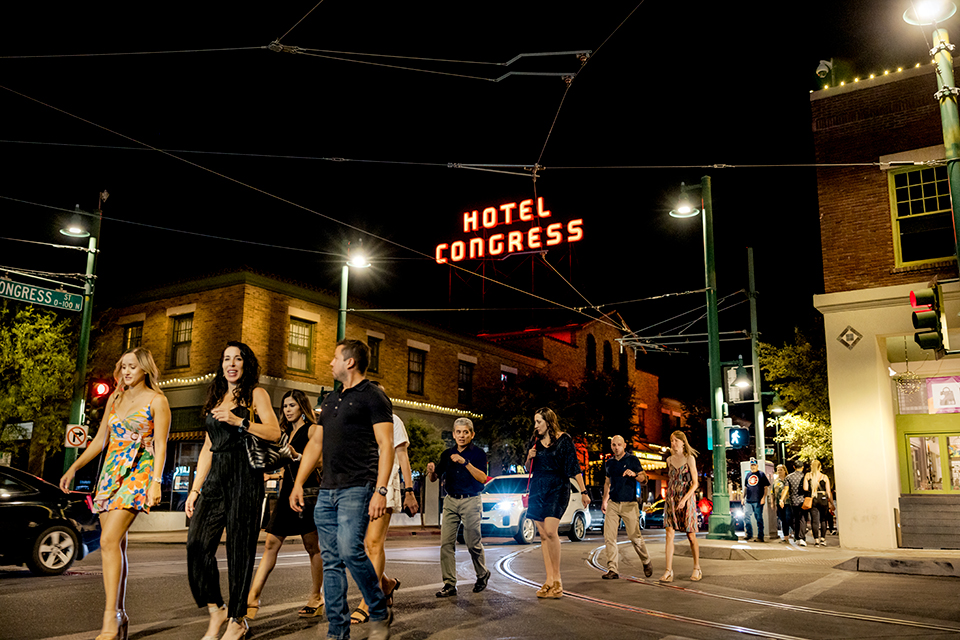
Just across the Santa Cruz River from the main downtown action, there’s the Mercado District with its shopping annex of repurposed shipping containers. It’s new, but perfectly in tune with the Tucson I knew and cherished 50 years ago: quirky, improvisatory, funky. Barrio Viejo has begun to sprout high-end art galleries, but also colorful murals celebrating the original Hispanic heritage of the neighborhood. And Don Rollings seems determined to preserve that culture wherever possible. “We’ve had tenants we haven’t raised rents on in 14 years,” he says. “We’re not in favor of things that are going to turn the neighborhood upside down.”
Tucson’s downtown revival doesn’t seem to be turning anything upside down except the dispiriting air of decline that dogged it for much of the past 50 years. There’s little danger of it becoming a theme park or a playground just for the wealthy. Tucson has always been a place that’s receptive to trying out idiosyncratic ideas, whether they’re pinball arcades or $7-a-bite appetizers. The wonderful thing is that these ideas are now germinating in the city’s heart.

